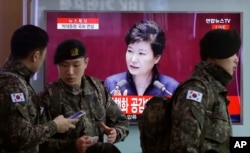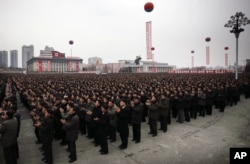The United States and South Korea will reportedly practice preemptive military strikes to take out North Korean nuclear sites next month when they begin the largest joint exercises ever conducted by the two allied forces.
In the wake of North Korea’s recent nuclear test and long-range rocket launch, Washington and Seoul will focus in part on defending against attacks by weapons of mass destruction during this year’s annual joint exercises.
In some scenarios being game planned by military strategists, the best defense is a good offense, one that would eliminate a North Korean missile site, nuclear facility or other strategic military target prior to an imminent attack.
“These types of exercises, this type of training, considering the nature of the threat, it’s going to be the new normal for North Korea, unless they were to roll back their nuclear program, which I don’t foresee that happening anytime soon,” said Northeast Asia security analyst Daniel Pinkston with Troy University in Seoul.
War games
This year’s annual U.S., South Korean joint military exercises will start on March 7 and will involve 15,000 American troops, four times more than the 3,700 troops that participated last year, according to South Korea’s Defense Ministry.
Australia, Canada and a number of other countries that fought with the U.S. during the Korean War from 1950 to 1953 will also likely either participate or send observers.
The annual joint exercises include the Key Resolve strategic simulation drill, where U.S. and South Korean troops and military assets are deployed to respond to potential North Korean threats, and field exercises called Foal Eagle.
The U.S. has already deployed four F-22 stealth fighters and a nuclear-powered submarine, the USS North Carolina, to South Korea.
For the joint exercises, the U.S. will bring more aircraft and assets, including the nuclear-powered carrier the USS John C. Stennis.
Over 4,500 American troops stationed in Okinawa, along with American V-22 Osprey tilt-rotor aircraft and the amphibious transport dock the USS New Orleans will take part in an amphibious landing drill.
Invasion rehearsal
North Korea has protested these exercises as rehearsals for invasion, while at the same time conducting its own operational readiness drills.
Washington and Seoul in the past have stressed the defensive nature of the exercises to counter criticism from Pyongyang and to ease concerns from Beijing.
While China opposes North Korea’s nuclear program, it also blames the ongoing U.S. military presence in South Korea for contributing to the tense regional security situation.
The emphasis on offensive options this year reflects an increased recognition in Washington and Seoul that the North Korean nuclear program presents a growing existential threat that must be addressed, one way or another.
“When you are brandishing nuclear weapons and you are making declaratory statements such as North Korea does, then you are putting yourself in a dangerous situation in a crisis,” Pinkston said.
Also on Monday, Seoul’s Defense Ministry announced that U.S. and South Korea will conduct a joint nuclear deterrence drill this week in Vandenberg Air Force Base in California. The drill is a computer simulation planning exercise against a potential North Korean nuclear threat.
Peace talks
The U.S. State Department Monday confirmed reports that officials from Washington and Pyongyang discussed entering into peace treaty talks prior to North Korea’s nuclear test on January 6.
Washington reportedly expressed an openness to negotiate a formal peace treaty to replace the 1953 armistice that halted the Korean War. The U.S. was willing to compromise its long held position that North Korea halt its nuclear program before any talks could occur, but did insist the nuclear issue to be part of the agenda. Pyongyang ultimately rejected this offer and proceeded with its fourth nuclear test.
The United Nations has banned North Korea from developing nuclear weapons and ballistic missile technology and has imposed increasingly stronger rounds of sanctions since 2006.
Washington recently passed harsh new financial sanctions that could seize the U.S. assets of any company linked to illicit North Korean activities.
THAAD
This week, South Korea and the U.S. will begin working level talks on the possible deployment the controversial Terminal High-Altitude Area Defense (THAAD) missile defense system.
China and Russia oppose THAAD deployment Korea, saying it can potentially be used against their military forces in the region.
Seoul had been hesitant to support THAAD to maintain good relations with Beijing its biggest trading partner, but following North Korea’s recent provocations, South Korea has come out in favor of deployment.
Youmi Kim in Seoul contributed to this report.

















